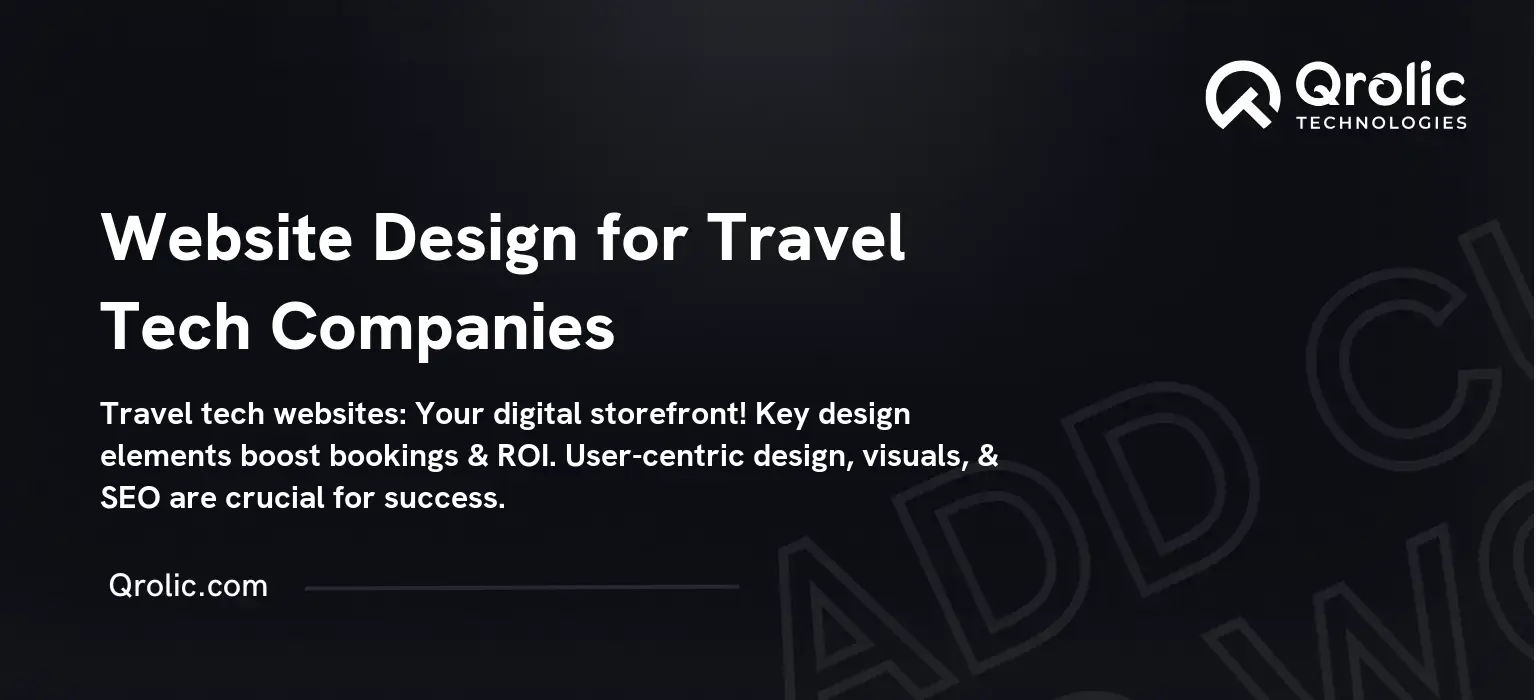The digital age has revolutionized the travel industry, creating unprecedented opportunities for businesses and travelers alike. A well-designed travel tech website is no longer a luxury; it’s a necessity for reaching your target audience, streamlining operations, and staying competitive. Whether you’re building a booking platform, a travel guide, or a community forum, understanding the essential steps involved in creating a successful travel tech website is crucial. This comprehensive guide delves into every aspect of the process, from initial planning to post-launch optimization, providing you with the knowledge and tools to build a website that not only meets your business needs but also delights your users.
Quick Summary:
- Define your niche and target audience first.
- Plan website goals, features, and how to earn money.
- Design, develop, test, and launch your website.
- Promote and maintain your travel tech site.
Table of Contents
- 1. Define Your Niche and Target Audience: The Foundation of Your Travel Tech Website
- 1.1 Identifying Your Travel Tech Niche: What Problem Are You Solving?
- 1.2 Defining Your Target Audience: Who Are You Building This Website For?
- 1.3 Analyzing Competitors: Learning from Successes and Failures
- 2. Planning and Conceptualization: Blueprint for Your Travel Tech Website
- 2.1 Defining Your Website’s Purpose and Goals: What Will Your Website Achieve?
- 2.2 Identifying Essential Website Features: Functionality that Delivers Value
- 2.3 Monetization Strategies: How Will Your Website Generate Revenue?
- 2.4 Creating a Sitemap and User Flow: Visualizing the Website Structure
- 3. Design and Development: Building Your Travel Tech Website
- 3.1 Choosing a Domain Name and Hosting Provider: Your Online Identity
- 3.2 Selecting a Content Management System (CMS): Powering Your Website
- 3.3 Designing the User Interface (UI): Creating an Engaging Experience
- 3.4 Developing the Website: Bringing Your Vision to Life
- 3.5 Content Creation and Population: Filling Your Website with Value
- 4. Testing and Optimization: Ensuring a Flawless User Experience
- 4.1 Website Testing: Identifying and Fixing Bugs
- 4.2 SEO Optimization: Improving Search Engine Visibility
- 4.3 User Experience (UX) Optimization: Enhancing User Satisfaction
- 5. Launch and Promotion: Getting Your Website Seen
- 5.1 Website Launch: Making Your Website Live
- 5.2 Marketing and Promotion: Reaching Your Target Audience
- 5.3 Social Media Integration and Engagement: Building a Community
- 6. Maintenance and Updates: Keeping Your Website Fresh and Relevant
- 6.1 Website Maintenance: Ensuring Optimal Performance
- 6.2 Content Updates: Keeping Your Content Fresh
- 6.3 Analytics and Reporting: Measuring Your Success
- 7. Future Trends in Travel Tech Websites
- 7.1 Artificial Intelligence (AI) and Chatbots: Personalized Travel Planning
- 7.2 Virtual Reality (VR) and Augmented Reality (AR): Immersive Experiences
- 7.3 Blockchain Technology: Secure and Transparent Transactions
- 7.4 Mobile-First Approach: Catering to Mobile Users
- 7.5 Personalization and Customization: Tailoring Experiences
- 8. Qrolic Technologies and Your Travel Tech Website
- Conclusion: Your Journey to a Successful Travel Tech Website
1. Define Your Niche and Target Audience: The Foundation of Your Travel Tech Website
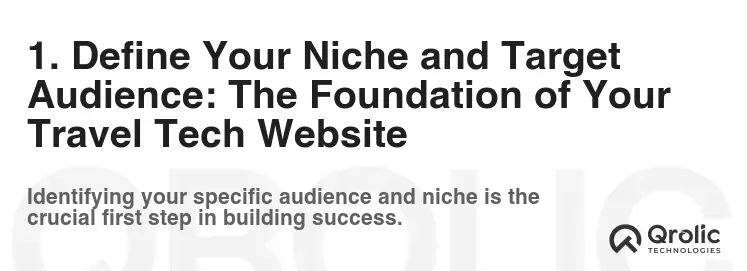
Before diving into the technical aspects of website development, you must clearly define your niche and identify your target audience. This foundational step will inform all subsequent decisions, from design and content to marketing and monetization strategies.
1.1 Identifying Your Travel Tech Niche: What Problem Are You Solving?
The travel industry is vast and multifaceted. Trying to cater to everyone will likely result in a diluted and ineffective website. Instead, focus on a specific niche within the travel sector. Consider these possibilities:
- Adventure Travel: Focus on providing information and resources for adventurous travelers seeking adrenaline-pumping experiences like hiking, rock climbing, diving, or extreme sports.
- Luxury Travel: Cater to affluent travelers seeking high-end accommodations, personalized service, and exclusive experiences.
- Budget Travel: Provide tips, resources, and deals for budget-conscious travelers looking to explore the world without breaking the bank.
- Family Travel: Target families with children, offering information on family-friendly destinations, activities, and accommodations.
- Sustainable Travel: Focus on eco-friendly travel options, responsible tourism practices, and destinations that prioritize environmental conservation.
- Culinary Tourism: Target food enthusiasts interested in exploring different cultures through their cuisine, offering restaurant reviews, cooking classes, and food tours.
- Specific Destination Focus: Become the go-to resource for a particular region or country, providing in-depth information and unique insights.
- Travel for Specific Interests: cater to the people of different specific interest like solo travel, pet travel, spiritual travel etc.
Key Questions to Ask:
- What are you passionate about in the travel industry?
- What are your areas of expertise?
- What are the unmet needs in the travel market?
- What are the emerging trends in travel?
- What geographical area are you targeting?
1.2 Defining Your Target Audience: Who Are You Building This Website For?
Once you’ve identified your niche, you need to understand your target audience intimately. This involves creating detailed user personas, which are fictional representations of your ideal customers.
Factors to Consider When Defining Your Target Audience:
- Demographics: Age, gender, location, income, education level, occupation.
- Psychographics: Interests, values, lifestyle, motivations, pain points.
- Travel Habits: Frequency of travel, preferred travel style, booking preferences, el companions.
- Technology Use: Comfort level with technology, preferred devices, social media usage.
- Search Behavior: Keywords they use when searching for travel information.
Creating User Personas:
Give your user personas names and backstories. For example:
- Adventure Annie: A 28-year-old female from San Francisco, working as a software engineer. She’s passionate about hiking, rock climbing, and exploring national parks. She’s tech-savvy and relies heavily on online reviews and recommendations.
- Luxury Larry: A 55-year-old male from New York City, working as a finance executive. He values high-end experiences, personalized service, and unique accommodations. He prefers booking through trusted travel advisors and reads luxury travel magazines.
- Budget Betty: A 22-year-old female from London, working as a freelance writer. She’s looking for affordable travel options and is willing to compromise on comfort to save money. She uses budget travel blogs and hostel booking websites.
Understanding your target audience allows you to tailor your website’s design, content, and marketing efforts to their specific needs and preferences. It will dramatically improve your chances of attracting and retaining loyal users.
1.3 Analyzing Competitors: Learning from Successes and Failures
No idea exists in a vacuum. Your analysis should include a thorough exploration of your competitors and how they conduct tourism technology design. Identify their strengths and weaknesses, their target audience, content strategy, marketing tactics, and website design.
Questions to Ask During Competitive Analysis:
- Who are your main competitors?
- What are their strengths and weaknesses?
- What is their target audience?
- What is their content strategy?
- What are their marketing tactics?
- What is their website design like?
- What are their pricing strategies?
- What are their customer reviews like?
2. Planning and Conceptualization: Blueprint for Your Travel Tech Website
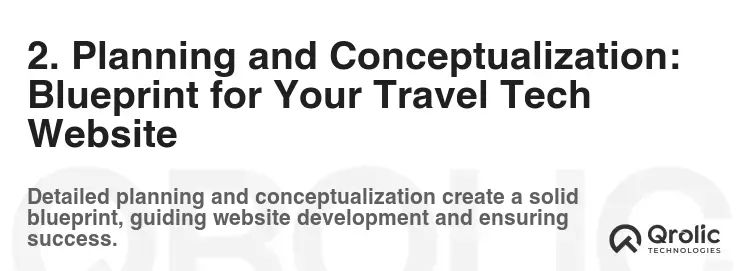
With a clear understanding of your niche and target audience, you can begin planning and conceptualizing your travel tech website. This stage involves defining your website’s purpose, features, and monetization strategies.
2.1 Defining Your Website’s Purpose and Goals: What Will Your Website Achieve?
Clearly articulate the purpose of your travel tech website. What problems will it solve for your target audience? What value will it provide? What are your specific goals for the website?
Examples of Website Purposes:
- To provide comprehensive travel guides for specific destinations.
- To facilitate booking of flights, hotels, and tours.
- To create a community forum for travelers to share experiences and tips.
- To offer curated travel itineraries and personalized recommendations.
- To showcase unique and off-the-beaten-path travel experiences.
- To become an authority on sustainable travel practices.
- To act as an affiliate platform connecting travelers with relevant products and services.
Setting SMART Goals:
Ensure your goals are SMART:
- Specific: Clearly defined and focused.
- Measurable: Quantifiable and trackable.
- Achievable: Realistic and attainable.
- Relevant: Aligned with your overall business objectives.
- Time-bound: With a specific deadline.
For example:
- Increase Website Traffic by 20% in the next three months.
- Generate 100 qualified leads per month.
- Achieve a conversion rate of 2% on booking requests.
- Rank for 10 target keywords in the top 10 search results within six months.
- Build an email list of 5,000 subscribers within one year.
2.2 Identifying Essential Website Features: Functionality that Delivers Value
Determine the essential features your travel tech website needs to provide value to your users and achieve your goals.
Common Travel Tech Website Features:
- Search and Filtering: Robust search functionality with advanced filtering options (e.g., destination, dates, price, amenities).
- Booking Engine: Integration with booking APIs for flights, hotels, tours, and activities.
- Destination Guides: Comprehensive information on destinations, including attractions, activities, restaurants, and accommodations.
- User Reviews and Ratings: Allow users to share their experiences and provide feedback on destinations, accommodations, and services.
- Interactive Maps: Integration with mapping services to display locations, routes, and points of interest.
- User Profiles: Allow users to create profiles, save their favorite destinations and itineraries, and track their travel history.
- Community Forum: A platform for travelers to connect, share tips, and ask questions.
- Blog: Publish informative and engaging articles on travel-related topics.
- Deals and Promotions: Highlight special offers and discounts on travel products and services.
- Payment Gateway Integration: Securely process online payments for bookings and other transactions.
- Mobile Responsiveness: Ensure the website is fully functional and visually appealing on all devices.
- Multi-Language Support: Cater to a global audience by offering the website in multiple languages.
- Currency Conversion: Allow users to view prices in their preferred currency.
- Customer Support: Provide assistance and support to users through email, chat, or phone.
Prioritizing Features:
Not all features are created equal. Prioritize the features that are most essential for your target audience and align with your website’s purpose.
2.3 Monetization Strategies: How Will Your Website Generate Revenue?
Determine how your travel tech website will generate revenue.
Common Monetization Strategies:
- Commissions: Earn commissions on bookings made through your website (e.g., flights, hotels, tours).
- Advertising: Display advertisements on your website (e.g., banner ads, sponsored content).
- Affiliate Marketing: Promote travel-related products and services and earn commissions on sales.
- Subscription Model: Offer premium content or features to paying subscribers.
- Data Licensing: License anonymized user data to travel companies and research firms.
- White Labeling: Provide your website platform to other businesses under their brand.
- Premium Listings: Offer enhanced listings to businesses for a fee.
- Donations: Accept donations from users who appreciate your content.
Choosing the Right Monetization Strategy:
The best monetization strategy depends on your website’s niche, target audience, and business model. It’s often beneficial to combine multiple monetization strategies to diversify your revenue streams.
2.4 Creating a Sitemap and User Flow: Visualizing the Website Structure
Develop a sitemap that outlines the structure of your website, including all pages and their relationships. Create user flows that illustrate how users will navigate through the website to accomplish specific tasks.
Benefits of a Sitemap:
- Provides a clear overview of the website’s structure.
- Helps ensure that all essential pages are included.
- Facilitates navigation for users and search engines.
Benefits of User Flows:
- Identifies potential usability issues.
- Ensures a smooth and intuitive user experience.
- Optimizes the conversion funnel.
3. Design and Development: Building Your Travel Tech Website
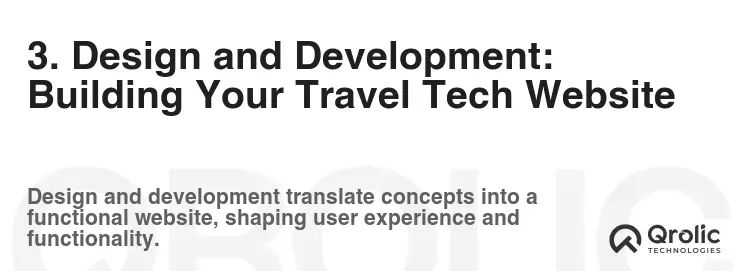
With a solid plan in place, you can begin the design and development phase of your travel tech website.
3.1 Choosing a Domain Name and Hosting Provider: Your Online Identity
Select a domain name that is relevant to your niche, easy to remember, and brandable. Choose a reliable hosting provider that can handle your website’s traffic and storage needs.
Domain Name Considerations:
- Relevance: Reflects your website’s content and purpose.
- Memorability: Easy to recall and type.
- Brandability: Unique and distinctive.
- Availability: Check domain name availability on various registrars.
- Extension: Choose the appropriate domain extension (e.g., .com, .net, .org, .travel).
Hosting Provider Considerations:
- Reliability: Uptime guarantee and server performance.
- Scalability: Ability to handle increasing traffic and storage needs.
- Security: Security measures to protect against cyber threats.
- Customer Support: Responsive and helpful customer support.
- Pricing: Competitive pricing and flexible plans.
- Features: Features such as email hosting, SSL certificates, and website backups.
3.2 Selecting a Content Management System (CMS): Powering Your Website
Choose a CMS that provides the flexibility, features, and scalability you need to manage your website’s content and functionality.
Popular CMS Options:
- wordpress: A widely used and versatile CMS with a large community and extensive plugin ecosystem.
- Drupal: A powerful and flexible CMS suitable for complex websites with custom requirements.
- Joomla: A user-friendly CMS with a balance of features and ease of use.
- Custom CMS: Develop a custom CMS tailored to your specific needs.
Choosing the Right CMS:
Consider the following factors when choosing a CMS:
- Ease of Use: How easy is it to learn and use the CMS?
- Flexibility: Can the CMS be customized to meet your specific needs?
- Features: Does the CMS offer the features you need?
- Scalability: Can the CMS handle your website’s growing traffic and content?
- Security: How secure is the CMS?
- Community Support: Is there a large and active community to provide support?
For many travel tech websites, WordPress is a solid starting point due to its flexibility through plugins and themes, its SEO-friendliness, and its ease of use.
3.3 Designing the User Interface (UI): Creating an Engaging Experience
Design a user interface that is visually appealing, intuitive to use, and aligned with your brand.
UI Design Principles:
- Simplicity: Keep the design clean and uncluttered.
- Consistency: Use consistent design elements and patterns throughout the website.
- Clarity: Make it easy for users to understand the website’s purpose and functionality.
- Accessibility: Design for users with disabilities.
- Responsiveness: Ensure the website is fully functional and visually appealing on all devices.
- Brand Alignment: Reflect your brand’s identity and values in the design.
Key Elements of UI Design:
- Layout: The arrangement of elements on the page.
- Typography: The choice of fonts and their styling.
- Color Palette: The selection of colors used in the design.
- Imagery: The use of photos, illustrations, and icons.
- Navigation: The structure and design of the website’s navigation.
3.4 Developing the Website: Bringing Your Vision to Life
Develop the website based on your design and specifications. This may involve coding, integrating third-party APIs, and configuring the CMS.
Development Considerations:
- Code Quality: Write clean, well-documented, and maintainable code.
- Performance Optimization: Optimize the website for speed and performance.
- Security: Implement security measures to protect against cyber threats.
- Cross-Browser Compatibility: Ensure the website works correctly on all major browsers.
- Testing: Thoroughly test the website to identify and fix bugs.
Using APIs for Travel Tech Websites:
Travel tech websites often rely on APIs (Application Programming Interfaces) to access and integrate with external data and services.
Common Travel APIs:
- Flights: Amadeus, Sabre, Travelport
- Hotels: Expedia, Booking.com, Agoda
- Tours and Activities: Viator, GetYourGuide, Klook
- Mapping: Google Maps, Mapbox
- Weather: OpenWeatherMap, AccuWeather
- Currency Conversion: Open Exchange Rates
3.5 Content Creation and Population: Filling Your Website with Value
Create high-quality, engaging, and informative content that is relevant to your target audience. Populate your website with this content.
Content Types:
- Destination Guides: Comprehensive information on destinations.
- Blog Posts: Articles on travel-related topics.
- User Reviews: Reviews and ratings of destinations, accommodations, and services.
- Photos and Videos: Visual content that showcases destinations and experiences.
- Interactive Maps: Maps with points of interest and travel routes.
- Itineraries: Curated travel itineraries for different destinations and interests.
- Deals and Promotions: Special offers and discounts on travel products and services.
Content Optimization:
Optimize your content for search engines to improve your website’s visibility.
- Keyword Research: Identify relevant keywords that your target audience is searching for.
- On-Page Optimization: Optimize your content for these keywords, including title tags, meta descriptions, headings, and body text.
- Image Optimization: Optimize your images for size and alt text.
- Internal Linking: Link to other relevant pages on your website.
4. Testing and Optimization: Ensuring a Flawless User Experience
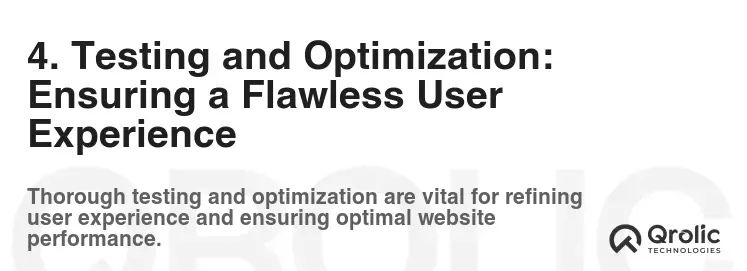
Before launching your travel tech website, it’s crucial to thoroughly test and optimize it to ensure a flawless user experience.
4.1 Website Testing: Identifying and Fixing Bugs
Conduct thorough testing to identify and fix any bugs or issues.
Types of Website Testing:
- Functional Testing: Verify that all features are working correctly.
- Usability Testing: Evaluate the website’s ease of use and user experience.
- Performance Testing: Assess the website’s speed and performance.
- Security Testing: Identify and address security vulnerabilities.
- Cross-Browser Testing: Ensure the website works correctly on all major browsers.
- Mobile Testing: Test the website on different mobile devices and screen sizes.
Tools for Website Testing:
- Browser Developer Tools: Built-in tools for debugging and inspecting website code.
- Website Speed Testing Tools: Google PageSpeed Insights, GTmetrix
- Usability Testing Tools: UserTesting.com, Hotjar
4.2 SEO Optimization: Improving Search Engine Visibility
Optimize your website for search engines to improve its visibility in search results.
SEO Best Practices:
- Keyword Research: Identify relevant keywords that your target audience is searching for.
- On-Page Optimization: Optimize your website’s content and structure for these keywords.
- Technical SEO: Ensure your website is technically sound and easy for search engines to crawl.
- Link Building: Build high-quality backlinks from other websites.
- Content Marketing: Create and promote valuable content to attract and engage your target audience.
- Mobile Optimization: Ensure your website is mobile-friendly.
- Site Speed Optimization: Reduce page load time for better search ranking.
4.3 User Experience (UX) Optimization: Enhancing User Satisfaction
Optimize the user experience to ensure that users are satisfied with your website.
UX Best Practices:
- Intuitive Navigation: Make it easy for users to find what they are looking for.
- Clear Calls to Action: Guide users towards desired actions.
- Mobile-Friendly Design: Ensure the website is responsive and easy to use on mobile devices.
- Fast Loading Speed: Optimize the website for speed and performance.
- Accessibility: Design for users with disabilities.
- User Feedback: Collect and analyze user feedback to identify areas for improvement.
Tools for UX Optimization:
- Analytics Platforms: Google Analytics, Adobe Analytics
- Heatmap Tools: Hotjar, Crazy Egg
- A/B Testing Tools: Optimizely, Google Optimize
- User Feedback Surveys: SurveyMonkey, Typeform
5. Launch and Promotion: Getting Your Website Seen

Once you’re confident that your travel tech website is ready, it’s time to launch it and start promoting it to your target audience.
5.1 Website Launch: Making Your Website Live
Carefully plan your website launch to ensure a smooth and successful rollout.
Pre-Launch Checklist:
- Backup: Create a backup of your website.
- DNS Propagation: Ensure that your domain name is properly configured and pointing to your hosting server.
- Testing: Perform final testing to verify that everything is working correctly.
- Analytics Setup: Install analytics tracking code to monitor website traffic and performance.
- Robots.txt: Create a robots.txt file to instruct search engine crawlers.
- Sitemap Submission: Submit your sitemap to search engines.
Launch Day Activities:
- Monitor Website Performance: Keep a close eye on website traffic and performance.
- Address Issues: Quickly address any issues that arise.
- Promote Your Website: Start promoting your website through various channels.
5.2 Marketing and Promotion: Reaching Your Target Audience
Implement a comprehensive marketing strategy to reach your target audience and drive traffic to your website.
Marketing Channels:
- Search Engine Optimization (SEO): Optimize your website for search engines.
- Social Media Marketing: Promote your website on social media platforms.
- Content Marketing: Create and promote valuable content to attract and engage your target audience.
- Email Marketing: Build an email list and send targeted email campaigns.
- Paid Advertising: Run paid advertising campaigns on search engines and social media.
- Influencer Marketing: Partner with travel influencers to promote your website.
- Public Relations: Reach out to media outlets to get coverage for your website.
- Affiliate Marketing: Partner with other websites to promote your website.
Key Marketing Considerations:
- Target Audience: Focus your marketing efforts on reaching your target audience.
- Budget: Allocate your marketing budget wisely.
- Metrics: Track your marketing results and make adjustments as needed.
5.3 Social Media Integration and Engagement: Building a Community
Integrate social media into your website to encourage sharing and engagement.
Social Media Integration:
- Social Sharing Buttons: Add social sharing buttons to your website to make it easy for users to share content.
- Social Login: Allow users to log in to your website using their social media accounts.
- Social Feeds: Display social media feeds on your website.
Social Media Engagement:
- Create Engaging Content: Share interesting and relevant content on social media.
- Interact with Your Audience: Respond to comments and questions.
- Run Contests and Giveaways: Encourage engagement and build your following.
- Use Hashtags: Use relevant hashtags to reach a wider audience.
6. Maintenance and Updates: Keeping Your Website Fresh and Relevant
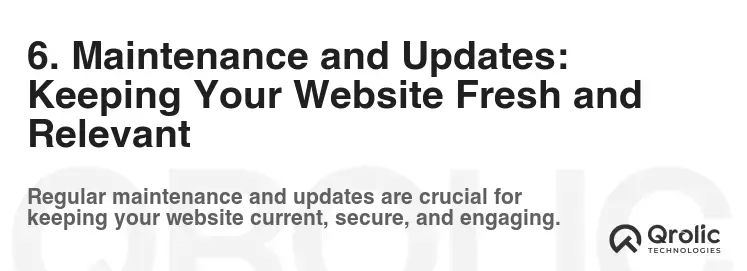
Maintaining and updating your travel tech website is essential for its long-term success.
6.1 Website Maintenance: Ensuring Optimal Performance
Regularly maintain your website to ensure optimal performance and security.
Maintenance Tasks:
- Software Updates: Keep your CMS and plugins up to date.
- Security Scans: Regularly scan your website for security vulnerabilities.
- Backup: Create regular backups of your website.
- Performance Monitoring: Monitor your website’s speed and performance.
- Broken Link Checking: Check for and fix broken links.
6.2 Content Updates: Keeping Your Content Fresh
Regularly update your website’s content to keep it fresh and relevant.
Content Update Strategies:
- Add New Content: Regularly add new destination guides, blog posts, and other content.
- Update Existing Content: Update existing content to reflect the latest information.
- Remove Outdated Content: Remove outdated content that is no longer relevant.
- Repurpose Content: Repurpose existing content into different formats (e.g., blog posts into videos).
6.3 Analytics and Reporting: Measuring Your Success
Track your website’s performance using analytics platforms and generate regular reports.
Key Metrics to Track:
- Website Traffic: Number of visitors, page views, and bounce rate.
- User Behavior: Time spent on site, pages visited, and conversion rates.
- Search Engine Rankings: Rankings for target keywords.
- Social Media Engagement: Likes, shares, and comments.
- Revenue: Revenue generated from bookings, advertising, and affiliate marketing.
Using Analytics to Improve Your Website:
Use analytics data to identify areas for improvement and make data-driven decisions.
7. Future Trends in Travel Tech Websites
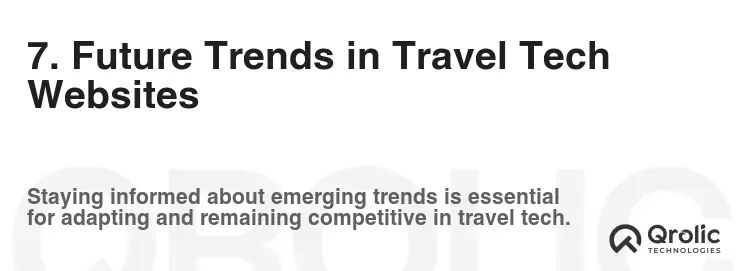
Staying ahead of the curve in the rapidly evolving travel tech landscape requires awareness and adaptation to emerging trends. Incorporating these trends can significantly enhance your website’s appeal and functionality.
7.1 Artificial Intelligence (AI) and Chatbots: Personalized Travel Planning
AI-powered chatbots can provide personalized travel recommendations, answer questions, and assist with booking processes. Implementing AI-driven features can significantly improve customer satisfaction and engagement.
7.2 Virtual Reality (VR) and Augmented Reality (AR): Immersive Experiences
VR and AR technologies offer immersive experiences that allow users to explore destinations virtually before booking. Integrating VR/AR features can differentiate your website and attract tech-savvy travelers.
7.3 Blockchain Technology: Secure and Transparent Transactions
Blockchain technology can enhance the security and transparency of online transactions, build trust with customers, and streamline booking processes.
7.4 Mobile-First Approach: Catering to Mobile Users
With the increasing use of mobile devices for travel planning, a mobile-first approach is essential. Ensure your website is fully optimized for mobile devices and offers a seamless user experience.
7.5 Personalization and Customization: Tailoring Experiences
Personalization and customization are key to attracting and retaining users. Offer personalized travel recommendations, customized itineraries, and tailored experiences based on user preferences and data.
8. Qrolic Technologies and Your Travel Tech Website
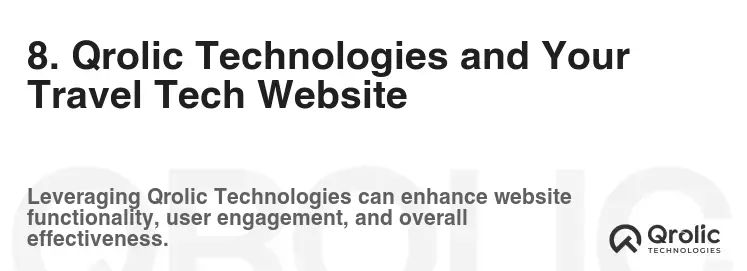
Qrolic Technologies (https://qrolic.com/) is a leading provider of technology solutions that can empower your travel tech website. With their expertise in web development, mobile app development, and custom software solutions, Qrolic Technologies can help you build a robust, scalable, and user-friendly platform.
How Qrolic Technologies Can Help:
- Custom Website Development: Qrolic Technologies can build a custom travel tech website tailored to your specific needs and requirements.
- Mobile App Development: They can develop native or hybrid mobile apps to complement your website and reach a wider audience.
- API Integration: Qrolic Technologies can seamlessly integrate with various travel APIs to provide real-time data and booking functionality.
- UI/UX Design: Their team of experienced designers can create a visually appealing and user-friendly interface.
- SEO and Digital Marketing: Qrolic Technologies can help you optimize your website for search engines and implement effective digital marketing strategies.
- E-Commerce Solutions: Secure and robust e-commerce solutions for handling bookings and payments.
By partnering with Qrolic Technologies, you can leverage their expertise and experience to create a travel tech website that stands out from the competition and achieves your business goals.
Conclusion: Your Journey to a Successful Travel Tech Website
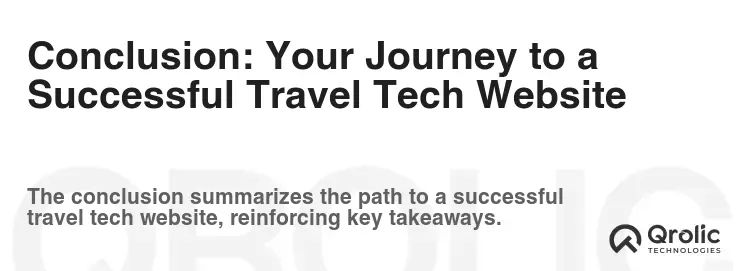
Creating a successful travel tech website is a multifaceted process that requires careful planning, execution, and ongoing optimization. By following the essential steps outlined in this guide, you can build a website that meets the needs of your target audience, generates revenue, and establishes your brand as a leader in the travel industry. Remember to stay adaptable, embrace emerging technologies, and continuously strive to enhance the user experience. The world of travel is constantly evolving, and your website must evolve with it to remain competitive and relevant. By investing in a well-designed, functional, and user-friendly travel tech website, you can unlock new opportunities and achieve lasting success in the digital age.

